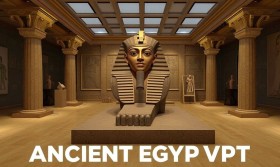Imagine stepping through a grand, marble-floored entrance hall. The air is cool and still, carrying the faint, nostalgic scent of old plastic and electronics—a smell you might remember from a long-closed local video store. Before you, a colossal, rotunda-style museum stretches out, its halls radiating from a central fountain that plays a pixelated water show. Welcome to the Video Game Museum VR, a digital sanctuary for the history of interactive entertainment. And the experience you’re about to have is powered by its latest and most ambitious expansion: the Retro Consoles DLC.
This isn't just a new set of games to play. It's a meticulously curated, fully interactive journey through the very hardware that defined generations. The base museum offered glimpses, but the Retro Consoles DLC is a deep dive. As you materialize in the lobby, your VR controller transforms into a universal remote of sorts, its interface now populated with new icons representing different console eras. A gentle, holographic prompt guides you towards a new wing, its entrance archway shaped like the iconic silhouette of a classic home computer.
Upon entering the "Hall of Hardware," the scale becomes apparent. It’s less a hallway and more a sprawling, chronologically-ordered landscape. You don't just see consoles behind glass; you inhabit their eras. The journey begins in the late 1970s. The carpet is a thick, garish orange shag, and wood paneling lines the walls. In a simulated living room, a bulky, beige box sits beneath a wood-grain CRT television. This is the Magnavox Odyssey. You can reach out, pick up the heavy, cable-bound controllers, and feel the satisfying click of its single knob. An info-plaque materializes, not just with text, but with a 3D schematic showing its primitive circuitry. This is the core of the DLC’s philosophy: context. You’re not just playing Pong; you’re understanding the technological marvel it represented at the time.

The exhibit seamlessly transitions into the Atari 2600 era. The shag carpet remains, but now the room is littered with those iconic joysticks and the cardboard game boxes. You can pick up a copy of Combat!, blow non-existent dust off the cartridge, and slot it into the console with a satisfying thunk. The museum doesn't just emulate the game; it emulates the entire ritual. The flick of the power switch, the channel selector set to "3," the warm glow of the tube TV as the game boots. It’s a multisensory history lesson.
Moving forward, the 8-bit revolution is marked by a shift in the architecture. The wood paneling gives way to brighter colors. Here, the Nintendo Entertainment System and the Sega Master System sit side-by-side, not as rivals in a store, but as respected artifacts. The DLC allows you to compare them directly. You can hold the NES's rectangular controller and feel its sharp edges, then immediately switch to the Master System's more ergonomic design. The information panels detail the "Console Wars" that were just beginning, the marketing strategies, and the cultural impact of mascots like Mario and Alex Kidd. You can play the original Super Mario Bros. on the NES and then experience the built-in game Snail Maze on the Master System, appreciating their different design philosophies.
The 16-bit section is a sensory explosion. The walls are adorned with bold, '90s geometric patterns. The Sega Genesis, with its "Blast Processing" marketing proudly displayed, hums with an attitude you can almost hear. The Super Nintendo, with its elegant purple and gray design, offers a more refined counterpoint. The DLC brilliantly showcases the technological differences. Playing Sonic the Hedgehog 2 on the Genesis feels faster, the colors slightly more saturated. Switching to Super Mario World on the SNES, you appreciate the system's advanced color palette and Mode 7 scaling effects. It’s a comparative analysis made playable. You can even examine the cartridges themselves, with the Genesis's larger shell and the SNES's more compact design, learning why they were incompatible.

One of the most magical features of this DLC is the "Developer's Corner." Scattered throughout the halls are interactive terminals. At the NES terminal, you can pull up a simplified version of a level from The Legend of Zelda and, using a basic node-based tool, change enemy placement or item locations, instantly seeing how the game would behave. At the Genesis terminal, you can manipulate the YM2612 FM sound chip, creating your own crude but authentic chiptune melodies. This demystifies the development process, creating a profound appreciation for the constraints these pioneers worked within.
The journey continues into the 32-bit and 64-bit eras, a time of radical experimentation. The museum's aesthetic becomes more futuristic and abstract. You find yourself in a circular room with three pillars: one for the Sony PlayStation, one for the Nintendo 64, and one for the Sega Saturn. This is where the DLC's interactive capabilities truly shine. You can pick up the revolutionary DualShock controller for the first time and feel the rumble in your VR hands as you crash a car in Ridge Racer Type 4. Then, you can grasp the unique, three-pronged design of the N64 controller and experience the analog stick that redefined 3D movement in Super Mario 64. The difference is jarring and enlightening. The Saturn, often the forgotten contender, gets its rightful place, with exhibits on its complex dual-CPU architecture and cult classics like Nights into Dreams.
Beyond the mainstream giants, the DLC features a "Curios and Cornerstones" wing. Here, you can find the virtual reality of the past, like the unwieldy VFX1 headset, or the ambitious but doomed 3DO Interactive Multiplayer. You can explore the portable revolution, from the brick-like Game Boy that defined durability to the sleek Sega Game Gear with its full-color, battery-draining screen. Each device is fully interactive, complete with its original packaging and advertising, placing it firmly within its historical and commercial context.
For those wondering about the practicalities, the process is seamless. Upon purchasing the DLC from your platform's store, it integrates directly into the base Video Game Museum VR application. The next time you launch the game, a short, elegant installation sequence plays, showing blueprints of classic consoles being constructed in the museum's previously locked wing. There is no complex setup. All new exhibits are immediately accessible from the main lobby map. The DLC is optimized for all major VR platforms, and the controls are intuitively mapped, whether you're using motion controllers or a gamepad. A comprehensive in-game manual, styled like an old issue of Nintendo Power, is available for quick reference.
This expansion does more than just provide a new list of games to play. It builds a narrative. It connects the dots between the Atari 2600's living-room dominance and the PlayStation's living-room revolution. It lets you feel the weight of a Sega Dreamcast controller, the last console of its kind, and understand its tragic, innovative story. You leave the Retro Consoles DLC not just with the satisfaction of having played a hundred classic games, but with a deeper, more tactile understanding of how we got here. You have held the history in your hands, heard its sounds, and seen its pixels in their original habitat. It is the definitive, most engaging way to experience the roots of modern gaming, preserving not just the software, but the soul of the hardware that made it all possible.



















